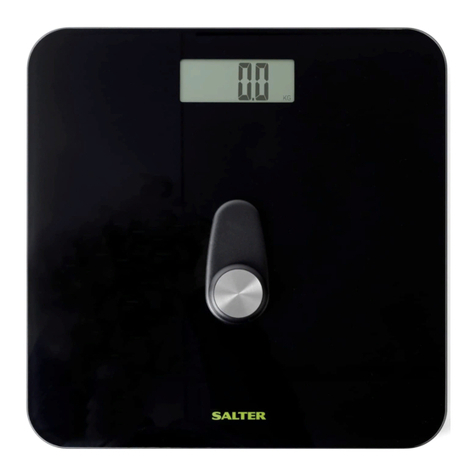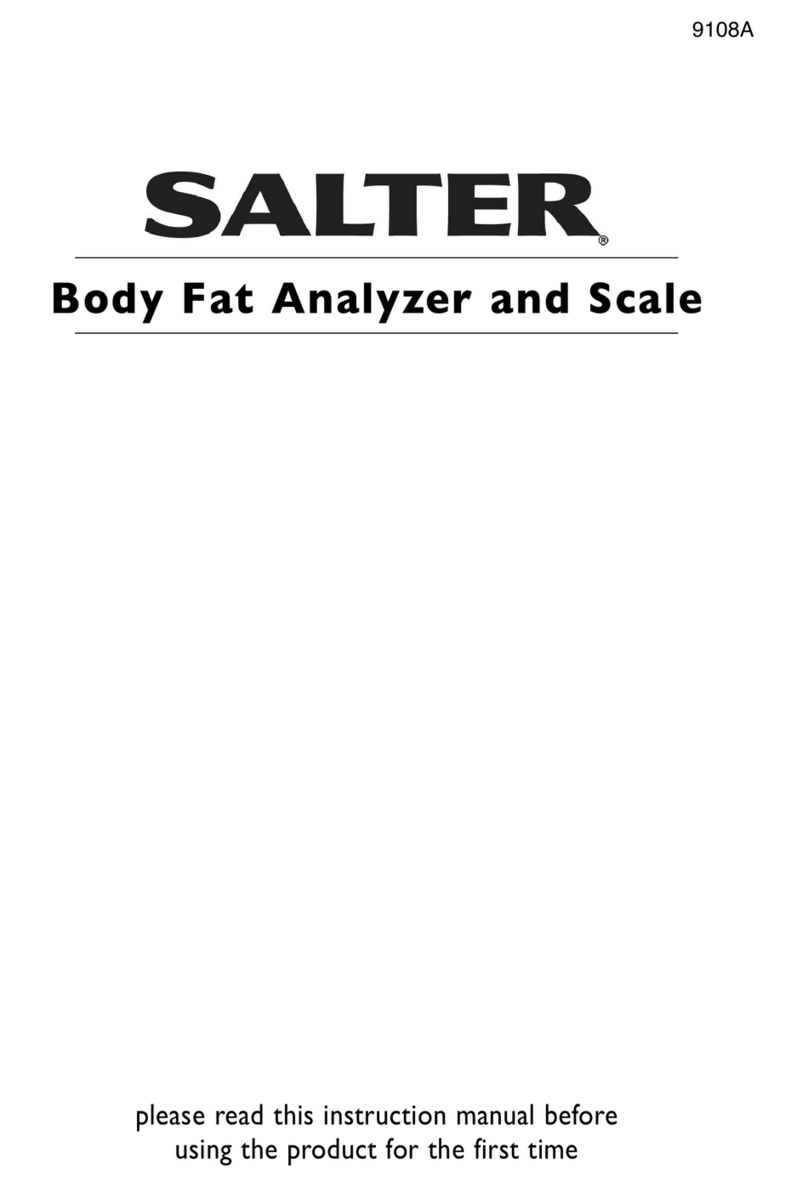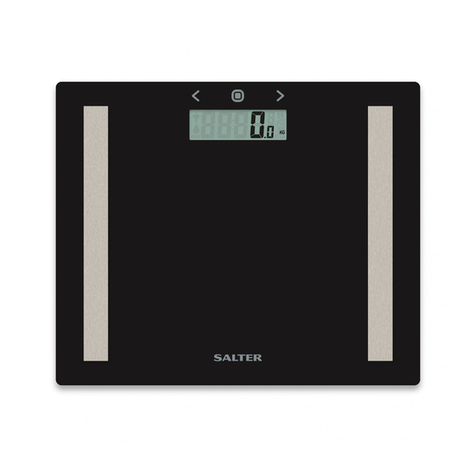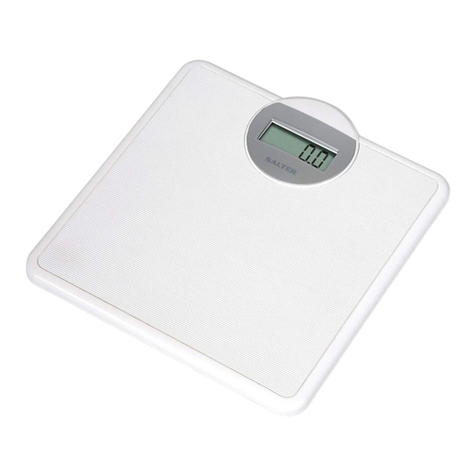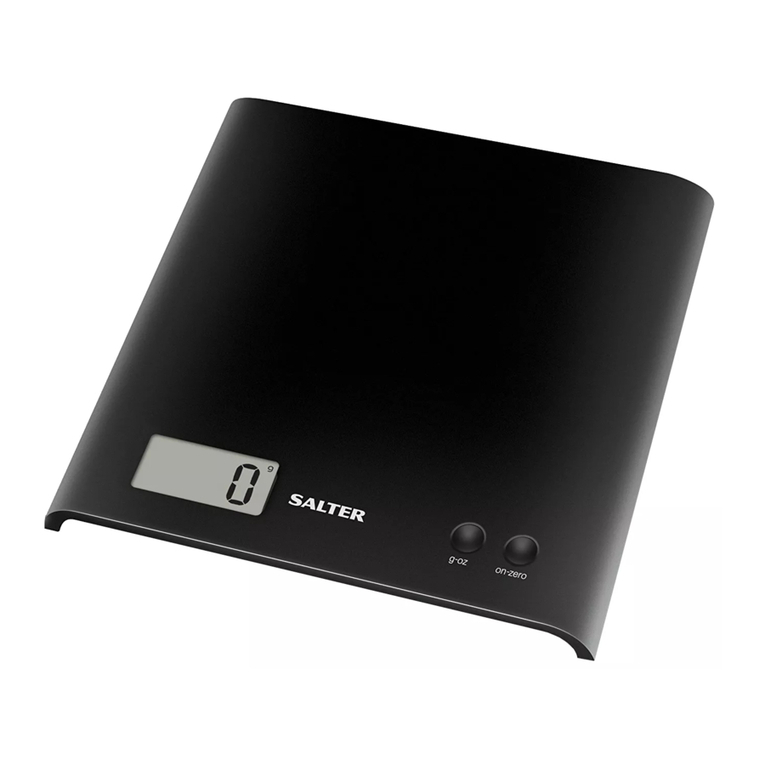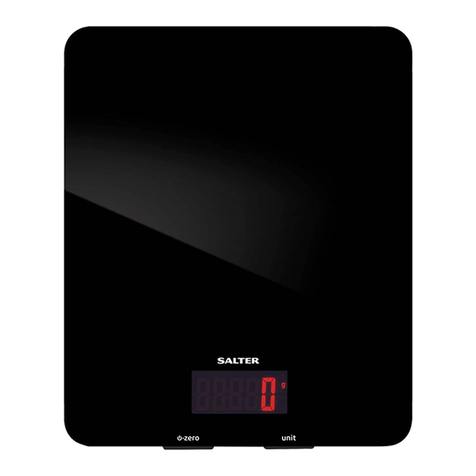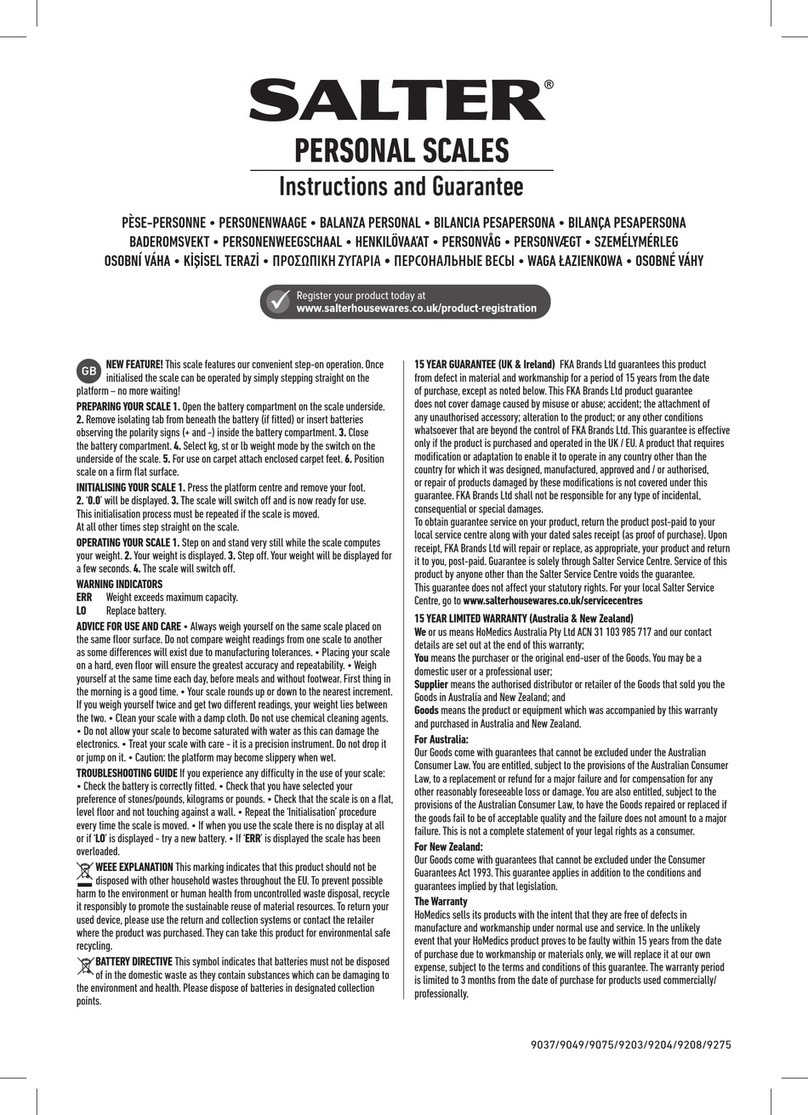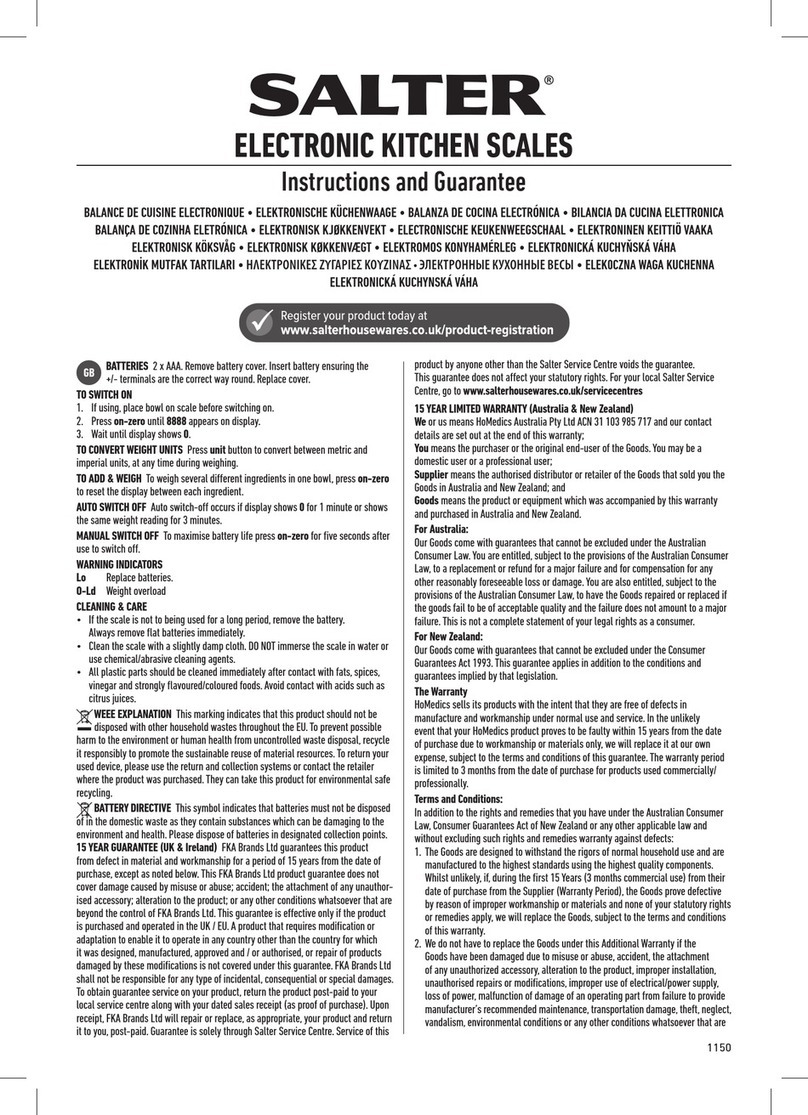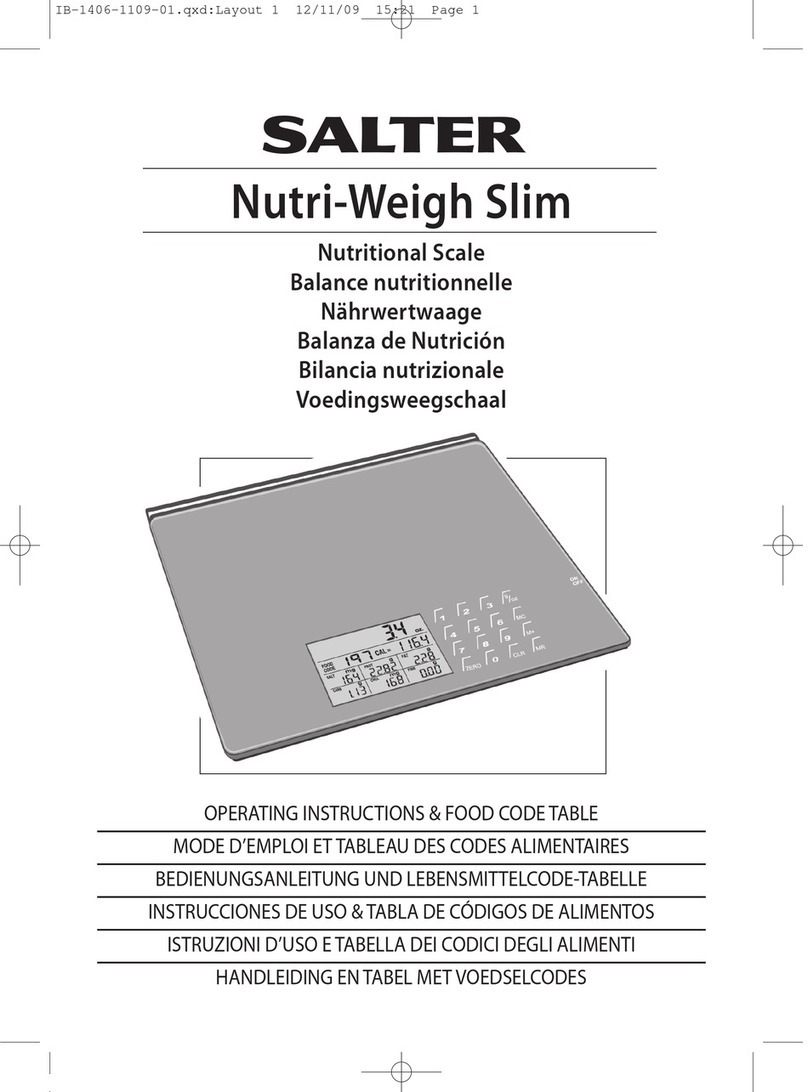HOW DOES THE BODY FAT ANALYSER SCALE WORK?
Fat cells and lean/muscle cells have dierent conductivity. Using a system known as
Bioelectrical Impedance Analysis (BIA) the body fat analyser passes a minute, harmless,
electrical impulse through the body to determine a resistance reading. This reading is
then processed along with the users age, weight, sex and height to calculate the body
fat and body water percentage. For the most consistent results only use the Salter
Body Analyser Scale when your body is normally hydrated (i.e. not following excessive
perspiration, nor just after a bath, nor after drinking a lot of water or alcohol).
PREPARING YOUR SCALE
1. Open the battery compartment on the scale underside.
2. Remove isolating tab from beneath the battery (if fitted) or insert batteries observing
the polarity signs (+ and -) inside the battery compartment.
3. Close the battery compartment.
4. Select kg, st or lb weight mode by the switch on the underside of the scale.
5. For use on carpet attach enclosed carpet feet.
6. Position scale on a firm flat surface.
WEIGHT READING ONLY
Position the scale on a flat level surface.
1. Press the button to turn the scale on.
2. ‘HI’ will be displayed followed by ‘1-12’.
3. Whilst ‘1-12’ is flashing, press button to enter weight reading only mode.
4. Zero is displayed.
5. Whilst zero is displayed, step onto the platform and stand still.
6. After a few seconds your weight is displayed.
PERSONAL DATA ENTRY
1. Press the button to turn the scale on.
2. ‘HI’ will be displayed followed by ‘1-12’.
3. While ‘1-12’ is flashing, press the button to activate the set-up procedure.
The current user number will flash.
4. While the user number is flashing, select a user number by pressing the or
buttons. Press the button to confirm your selection.
5. The male or female symbol will flash.
Press
button until the correct symbol is flashing, then press the button.
6. The height display will flash.
Press
or as necessary to set your height, then press the button.
7. The age display will flash.
Press
or as necessary to set your age, then press the button.
Child mode:
When the age is set from 6-12 years child mode is automatically selected.
A small child icon will appear.
8. ‘1-12’ will flash, then your height and gender will be displayed.
Wait for ‘0.0’ to be displayed, then allow the scale to switch o. The memory is then set.
9. Repeat procedure for a second user, or to change user details.
Note: To update or overwrite the memorised data, follow the same procedure, making
changes as required.
Tip: During the set-up procedure press to quit and start again at any time.
WEIGHT & BODY FAT READINGS
Position the scale on a flat level surface.
1. Press the button to turn the scale on.
2. ‘HI’ will be displayed followed by ‘1-12’.
3. While ‘1-12’ is flashing, select your user number by pressing the or buttons. Your
height and gender will be displayed.
4. Zero will be displayed.
Athlete Mode:
To select Athlete Mode press the button. A small athlete icon will appear.
Note: This feature is only available to those aged between 15-50 years.
An athlete is defined as a person who is involved in intense physical activity of
approximately 12 hours per week and who has a resting heart rate of approximately
60 beats per minute or less.
5. When zero is displayed, with bare feet, step onto the platform and stand still.
6. After 2-3 seconds your weight will be displayed.
7. Remain standing on the scale while your other readings are taken.
8. Your body fat % (F) and total body water % (W) are displayed.
The results are repeated then the scale switches o.
BODY FAT -WHAT DOES IT MEAN?
The human body is made up of, amongst other things, a percentage of fat. This is vital
for a healthy, functioning body - it cushions joints and protects vital organs, helps
regulate body temperature, stores vitamins and helps the body sustain itself when food
is scarce. However, too much body fat or indeed too little body fat can be damaging to
your health. It is dicult to gauge how much body fat we have in our bodies simply by
looking at ourselves in the mirror. This is why it is important to measure and monitor
your body fat percentage. Body fat percentage gives you a better measure of fitness
than weight alone – the composition of your weight loss could mean you are losing
muscle mass rather than fat - you could still have a high percentage of fat even when a
scale indicates ‘normal weight’.
NORMAL HEALTHY RANGE OF BODY FAT PERCENTAGEBod Fat %
Body Fat % Ranges for Boys*
Age Low Optimal Moderate High
6 ≤12.4 12.5 -19.5 19.6 - 22.6 ≥22.7
7 ≤12.6 12.7 - 20.4 20.5 - 24.0 ≥24.1
8 ≤12.7 12.8 - 21.3 21.4 - 25.4 ≥25.5
9 ≤12.8 12.9 - 22.2 22.3 - 26.7 ≥26.8
10 ≤12.8 12.9 - 22.8 22.9 - 27.8 ≥27.9
11 ≤12.6 12.7 - 23.0 23.1 - 28.2 ≥28.3
12 ≤12.1 12.2 - 22.7 22.8 - 27.8 ≥27.9
13 ≤11.5 11.6 - 22.0 22.1 - 26.9 ≥27.0
14 ≤10.9 11.0 - 21.3 21.4 - 25.8 ≥25.9
15 ≤10.4 10.5 - 20.7 20.8 - 24.9 ≥25.0
16 ≤10.1 10.2 - 20.3 20.4 - 24.2 ≥24.3
17 ≤9.8 9.9 - 20.1 20.2 - 23.8 ≥23.9
18 ≤9.6 9.7 - 20.1 20.2 - 23.5 ≥23.6
Body Fat % Ranges for Girls*
Age Low Optimal Moderate High
6 ≤14.4 14.5 - 23.0 23.1 - 26.1 ≥26.2
7 ≤14.9 15.0 - 24.5 24.6 - 27.9 ≥28.0
8 ≤15.3 15.4 - 26.0 26.1 - 29.6 ≥29.7
9 ≤15.7 15.8 - 27.2 27.3 - 31.1 ≥31.2
10 ≤16.0 16.1 - 28.2 28.3 - 32.1 ≥32.2
11 ≤16.1 16.2 - 28.8 28.9 - 32.7 ≥32.8
12 ≤16.1 16.2 - 29.1 29.2 - 33.0 ≥33.1
13 ≤16.1 16.2 - 29.4 29.5 - 33.2 ≥33.3
14 ≤16.0 16.1 - 29.6 29.7 - 33.5 ≥33.6
15 ≤15.7 15.8 - 29.9 30.0 - 33.7 ≥33.8
16 ≤15.5 15.6 - 30.1 30.2 - 34.0 ≥34.1
17 ≤15.1 15.2 - 30.1 30.2 - 34.3 ≥34.4
18 ≤14.7 14.8 - 30.8 30.9 - 34.7 ≥34.8
Body Fat % Ranges for Men**
Age Low Optimal Moderate High
19 - 39 ≤8 8.1 - 19.9 20 - 24.9 ≥25
40 - 59 ≤11 11.1 - 21.9 22 - 27.9 ≥28
60+ ≤13 13.1 - 24.9 25 - 29.9 ≥30
Body Fat % Ranges for Women**
Age Low Optimal Moderate High
19 - 39 ≤21 21.1 - 32.9 33 - 38.9 ≥39
40 - 59 ≤23 23.1 - 33.9 34 - 39.9 ≥40
60+ ≤24 24.1 - 35.9 36 - 41.9 ≥42
*Source: Derived from; HD McCarthy, TJ Cole, T Fry, SA Jebb and AM Prentice: “Body fat reference curves for children”.
International Journal of Obesity (2006) 30, 598–602.
**Source: Derived from; Dympna Gallagher, Steven B Heymsfield, Moonseong Heo, Susan A Jebb, Peter R Murgatroyd,
and Yoichi Sakamoto: “Healthy percentage body fat ranges: an approach for developing guidelines based on body mass
index1–3”. Am J Clin Nutr 2000;72:694–701.
The Body Fat % ranges published are for guidance only. Professional medical guidance should always be sought before
embarking on diet and exercise programs.
BODY WATER -WHY MEASURE IT?
Body water is the single most important component of body weight. It represents over
half of your total weight and almost two thirds of your lean body mass (predominantly
muscle). Water performs a number of important roles in the body:
All the cells in the body, whether in the skin, glands, muscles, brain or anywhere else,
can only function properly if they have enough water. Water also plays a vital part in
regulating the body’s temperature balance, particularly through perspiration.
